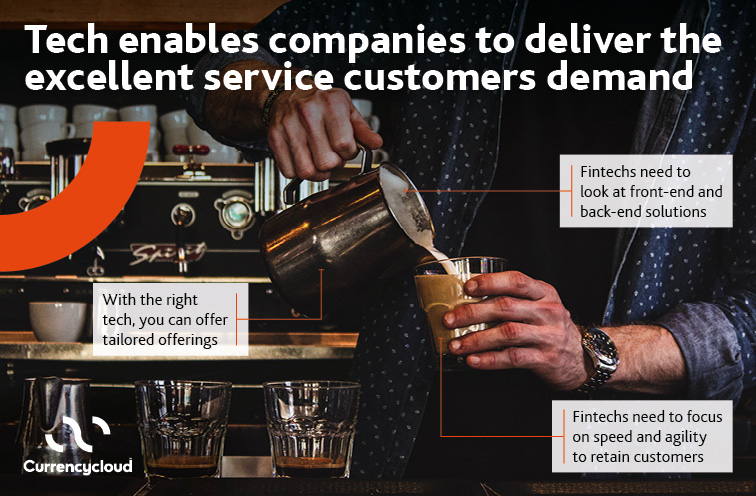Poor customer experience (CX) is the biggest reason for consumers and businesses to switch suppliers. The bar is set high by digital-first organizations that beat traditional vendors on convenience, price, choice, personalization and speed/accuracy in delivery.
It’s no different for financial institutions competing for customers in the SME and ‘gig economy’ sectors. To win, they must pay close attention not just to the way they provide services via various touchpoints, but how customers interact with them across an entire journey – from initial enquiry to post-purchase support.
Related articles to read next:
Digital KYC – why it’s finger-clickin’ good
Empowering our clients through better customer experience
In other words, successful fintechs need to do more than provide a cool website and build an app as a one-off customer experience (CX) digitization exercise. As the worlds of work and leisure blend, small businesses and sole traders want banking services that are as immersive and easy to use as the systems they use to order groceries or communicate with friends and family.
Unless fintechs consult their customers on a regular basis, the first time they may realize their customers are planning to leave for a competitor is when they close down their account. By understanding what SMEs want from the CX on offer, fintechs can prevent this from happening.
Request a demo today:
Click here to find out what Currencycloud can do for your business
First step: analysis
So where should they start? The first step is an analysis of what’s offered today, what traditional competitors are offering and where digital-first brands are leading the way. For example, there’s a growing tendency for banks and fintechs to provide information and services beyond core banking services like current accounts and loans.
But that doesn’t mean fintechs need to build new capabilities from scratch. In the days of Open APIs and collaboration, firms are extending their propositions and capabilities by building in white-labeled capabilities built and maintained by third parties. These can include customer-facing services such as money management apps or FX and cross-border payments. Or they can include helpful, value-added services such as training. Dutch digital-only challenger Knab specializes in working with entrepreneurs and small businesses and allows them to begin banking on the same day, for example. It also plans to give business customers access to training courses at an attractive rate via its app.

Another success factor is to change thinking from ‘how do we digitize a process’ to ‘how do customers think and what could we do to make their lives easier’. This means considering how SMEs and those working in the professional gig economy move through their working days – and how technology could improve the way they manage their money.
For example, chasing unpaid invoices is a time-consuming task for any small business. If a fintech has access to data from an SME’s accounting system, it could potentially flag overdue invoices and offer to follow up on late payments too.
Valued local knowledge
And for the growing number of SMEs and individuals either servicing cross border business or setting up new entities, fintechs can do more than just provide transparent and accurate FX arrangements. For example, it can also help clients understand local import and tax information as well as how to lease manufacturing equipment or take out office space in a different country.
In addition to improving front-end, customer-facing CX, third-party technology can help fintechs with ‘behind the scenes’ systems that do the heavy lifting on processes. This can include account opening and onboarding, loan decision-making, credit checking and know your customer (KYC).
A fintech that can demonstrate agility and speed with those processes is more likely to attract and retain customers than one that continues to operate clunky, sub-optimal processes that take days to complete rather than hours or even minutes.
Whether customer facing or operating behind the scenes, both types of systems help to improve CX by making products and services on offer easier to acquire. This reduces friction in the supply chain and improves the customers’ work and leisure life.
The next stage is to improve CX still further by analyzing how, when and even why customers make the decisions they do. Using these insights, financial institutions can go beyond the reactive supply of standard products and services to suggest relevant and tailored offerings.
Real-time analysis
According to digital banking commentator Jim Marous: “Advanced analytics allows a bank marketer to not only identify potential sales opportunities more accurately but to do so in real-time. In the best situation, advanced analytics will identify who may need a specific product or service before the customer knows this themselves.”
Sources of insight may go beyond the fintech’s own data and includes sentiment reporting and social media, for example. These types of insight are also available as components from third parties and can be plugged into a central analytics platform via Open APIs.
For any of this to work, firms need to assess the third parties they work with carefully to make certain they can share customer data safely while ensuring that they don’t jeopardize the smooth running of their own service.
“Advanced analytics allows a bank marketer to not only identify potential sales opportunities more accurately but to do so in real-time.”
If they haven’t already, they also need to change the way they operate internally, from organizational silos to integrated teams. Instead of having teams that look after product sets, they always need to take a holistic view of the customer and all of the ways in which they interact with them.
Focus on customer experiences
As Mckinsey and Co. writes in The heartbeat of modern marketing: Data activation and personalization: “Designing great offers…is hampered by the fact that functions and departments within companies tend to operate as mini-fiefdoms. The owners of each channel test and engage consumers exclusively within their own channel. Real benefits can only occur when companies shift to “war rooms” of people from relevant functions (marketing, digital, legal, merchandising, and IT/DevOps) who focus on specific consumer segments or journeys.”
The concept that ‘if we build it they will come’ is now hopelessly outdated. Fintechs need to focus in on what business customers want to experience, rather than concentrate on encouraging them to join or switch with financial incentives. And signing up a new small business customer is just the start: to retain them fintechs need to continuously rethink the products and services they provide, which channels they use and work towards identifying marketing to audiences of one.
New eBook: “Why the future of payments is modular and cloud-based”
Modular, cloud-based payments technology is the way of the future, and the fintech companies that don’t embrace this new payments era will quickly fizzle out.
Our new guide, “Why the future of payments is modular and cloud-based” will tell you everything you need to know about the latest innovations in the payments world.




